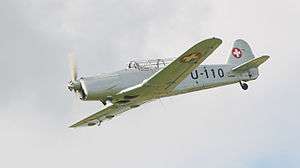Pilatus P-2
| P-2 | |
|---|---|
 | |
| Role | Trainer |
| National origin | Switzerland |
| Manufacturer | Pilatus Aircraft |
| First flight | 27 April 1945 |
| Retired | 1981 |
| Primary user | Swiss Air Force |
| Number built | 55[1] |
The Pilatus P-2 is a trainer aircraft designed by Swiss manufacturer Pilatus in 1942 and first flown on April 27, 1945. It was used by the Swiss Air Force from 1946 until 1981. The Pilatus P-2 emerged from an unbuilt project of the Pilatus P-1, which can be seen as a single-seat version of the P-2.
Design and development
The P-2 is a low-wing monoplane of mixed construction (metal, wood and canvas) with a fully retractable tailwheel undercarriage and dual control tandem seating. To save cost, several parts came from older Swiss AF machines, for example landing gear parts from their Messerschmitt Bf 109s. There were two series of production machines, one (P-2-05) unarmed and the second (P-2-06) equipped as weapons trainers, with a machine gun above the engine and wing racks for light bombs and rockets.
After the end of their Swiss Air Force service, the survivors (numbering about 48) were sold into civilian service. In 2008 at least 23 appeared on the national registers of Switzerland, Germany, France, the United Kingdom and the United States. They proved to be a popular civil flyer's aeroplane and have often appeared in Luftwaffe garb in films and airshows as an unidentified "enemy" aircraft.
Variants


- P-2-01
- First prototype (HB-GAB/A-101/U-101), Argus-powered.
- P-2-02
- Non-flying static testframe.
- P-2-03
- Hispano-Suiza HS-12Mb upright V water-cooled engined prototype. Large ventral radiator.
- P-2-04
- Armed version of P-2-03.
- P-2-05
- Production version of unarmed machine, Argus motor. 26 delivered to Swiss AF.
- P-2-06
- Production version of armed machine, Argus motor. 26 delivered to Swiss AF.
Operators
Specifications (P-2-05)
General characteristics
- Crew: two
- Length: 9.07 m (29 ft 9 in)
- Wingspan: 11 m (36 ft 1 in)
- Height: 2.70 m (8 ft 10¼ in)
- Wing area: 17 m2 (182.99 ft2)
- Empty weight: 1380 kg (3040 lb)
- Gross weight: 1800 kg (3970 lb)
- Powerplant: 1 × Argus As 410 A-2 inverted Vee air-cooled engine, 347 kW (465 hp)
Performance
- Maximum speed: 340 km/h (211 mph)
- Cruising speed: 306 km/h (190 mph)
- Range: 865 km (537 miles)
- Service ceiling: 6600 m (21,654 ft)
- Rate of climb: 6.5 m/s (1280 ft/min)
See also
Related development
References
| Wikimedia Commons has media related to Pilatus P-2. |
- ↑ http://www.samoloty.ow.pl Archived 2011-12-08 at the Wayback Machine.
- ↑ Orbis 1985, page 2717
- ↑ Green & Pollinger, page 134
- The Illustrated Encyclopedia of Aircraft (Part Work 1982-1985). Orbis Publishing.
- Green, W & Pollinger, G, The World's Fighting Planes (1954). London: MacDonald.